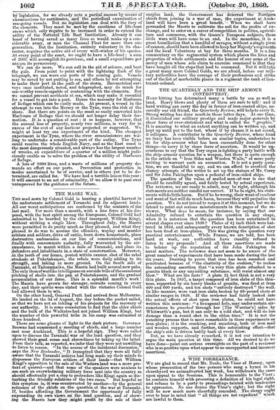THE QUARTERLY AND THE SHIP ARMOUR CONTROVERSY.
HAIM hitting has determined many a battle by sea RS well as land. Heavy blows and plenty of them are sure to tell ; and if hard- writing can carry the day in favour of iron-coated.ships, as- suredly our old friend, the Quarterly Review, willhelP to carry it. Strong writing has done much in these latter days. At one time, it diminished our military prestige and made major-generals by sheer force of over-statement and what is called the "sraphic." It is amazing to what an extent anything can be written up, and kept up until put to the test, where if -by chance it is not sound, it collapses. A contributor to the Quarterly Review, whose hand we fancy has been visible before on similar topics' undertakes to do for ship-armour what 'has been successfully done for other things—to carry it by sheer force of assertion. It would be u4- courteous to-say that the Tory organ is fighting a party battle with the ship-armour question for a weapon, but there is quite enough in the article on Iron Sides and Wooden Walls," of mere party writing to warrant such an accusation. It is not a party ques- tion, we are thankful to say, and we can afford to overlook the clumsy attempts of the writer to set up the statues of Mr. Corry and Sir John Pakington upon a pedestal of iron-sided ships. The cinestion of the value of mailed men-of-war is one that should be candidly agued, and fairly tested by actual experience. The reviewer, we are ready to admit, may be right, although his statements are neither candid nor correct. If he be right, his state- ments willdolittleharm. Butif he be wrong, their want of candour and want of fact will do much harm, because they will prejudice the question. We do not intend to reopen it at this moment, but we do intend to point out serious misstatements in the pages of the re- viewer. 'What does he mean, for instance, by saying that our Admiralty refused to entertain the 'question in -any shape, when it is notorious that the question has been entertained in several shapes ever since 1838 ? Plates of 41 inch thick were-bat- tered in 1854, and subsequently every known description of shot has been fired at iron-plates. This was giving the question very practical entertainment. While France, we are told, has been hard at work, our authorities 'have steadily refused 'to listen to any proposals-! And all these assertions are made to bolster up the reputation of Sir John Pakington in naval matters. The reviewer does not seem to be aware of -the great number of experiments that have been made during the last six years. Desiring to prove that iron has been smashed and penetrated because of " the elasticity of the cushion," he makes the astounding assertion that "a -very thin plate attached toe. granite block or any unyielding substance, will resist almost any blow." What- are the facts ? A- plate 24, feet thick is not a very thin plate. In 1857, a target composed of iron slabs of this thin- ness, supported by six-heavy blocks of granite, was fired at from 400 and-600 yards, and ten shots "entirely destroyed " the wall. In-like-manner, were vast iron slabs broken by 68-pound shots at similar ranges in 1858. If the reviewer had fairly looked -into the actual effects of shot upon iron plates, he could -not have written this sentence: "a hexagonal hole -may under certaincir- cumstances be punched through her [The Warrior's] sides by 'Whitworth's gun, but it can only be a cold shot, and willdo-less damage -than -a round shot in the olden time." It is not - the Punching process that is most remarkable in these experiments en iron-plates ; it is the cracking, and smashing, both of iron mail and wooden supports, and 'further, this astonishing effect-.-that the ship's side is driven bodily =back at every blow."
But, as we have already remarked, it is not our intention to argue the maim question at this time.- All we desired to do we have-done—point out serious oversights on the part-of a-reviewer wile is so positive upon what appear tons unsupported and incorrect assertions.


























 Previous page
Previous page